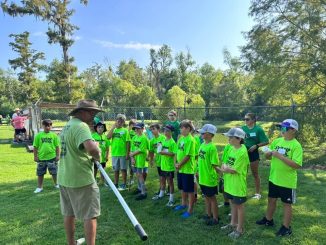
78 perished when tanker, ferry collided
Kenneth Songy was driving to work when he heard news of the SS Frosta colliding with the George Prince ferry in Luling, but wasn’t concerned because he thought his son had crossed the Mississippi River earlier.
A half hour later, his wife called him at work and it turned out he was wrong.
Songy still remembers his son, Richard Mark Songy, for having fun, being very bright and loving life.In the many years since the disaster, the anniversary of his son’s death “hits a sore spot every year,” he said. “He’s really missed.”
Now at age 89, Songy just wishes he wouldn’t have to think about the loss anymore, even on the 40th anniversary of the Luling Ferry Disaster.
It was Oct. 20, 1976 at 6 a.m. when Frosta, a 22,000-ton Norwegian tanker, and the 50-year-old ferry collided head-on, leading to the death of 78 aboard the George Prince. Some 16 people are said to have survived the disaster.
One of them was Charles Chatalain, who was living in River Ridge and used the ferry to get to work at Texaco in Paradis in the morning for 12 years. To go home, he used the Huey P. Long Bridge.
On the morning of the disaster, it was cold and the passengers had huddled in the passenger room of the ferry.
“Mostly I recall catching the 6 A.M. ferry and they brought me right in front of the passenger room,” Chatalain said. “I could hear horns blowing, but I couldn’t see anything from where the cars were parked. “The last thing I saw was the ferry running over the people that had walked onto the ferry. It happened so fast. I saw the ship. By the time I reached for the door, I was under the water.”
Chatalain and his truck plunged into the water. The windows were up, but he was too afraid to open the door although he somehow kicked out the windshield and it shot him out of the truck.
“When I was out in the river, I couldn’t see anything,” he said. “Things were bumping into me. I could feel drums from the ferry with oil or whatever. I started swallowing the water. I had gone down pretty deep I guess. I couldn’t hold my breath anymore. I was blowing out and sipping, I could feel diesel and river water going down my throat. I finally came up, downstream from New Orleans. I had to swim back a block or so and climbed back on top the ferry and I threw up. I had swallowed all that nasty stuff.”
Chatalain said the other ferry shined a light on him and announced it was coming to get him. He was taken to the Luling hospital and later to East Jefferson General Hospital.
“I felt bad for all those people that got killed,” he said. “I was just plain lucky not to have been killed. I got as close to being killed without being killed that day.”
The ferry had just left the Destrehan dock and was easing across the river toward Luling when it collided with the tanker and went into history as the worst ferry disaster in the nation.
Songy said it seems like the disaster occurred just a few years ago.
“I went home and we found out he was on it,” he said. “We went to spend the time with his wife and three-month-old son until they started bringing the bodies up from the ferry,” he said. “My son was one of the first ones they brought up from inside the cabin of the ferry.”
His son had a large bruise on his forehead, suggesting he hit his head in the collision.
“He probably didn’t know what was going on,” Songy said.
For this father, it’s been the bright moments about his son, one of seven children, that rises above the sadness of the loss.
“He just got along with everybody. He was very good at automobile mechanics,” he said. “He loved hunting and fishing. He’d spend his nights working on cards and a lot of times I’d have to go get him and tell him to go bed.”
The disaster prompted a change in maritime law giving large ships right of way on the river and required all vessel employees undergo random drug and alcohol testing.
Seven years after the disaster, construction of Hale Boggs Memorial Bridge ended the need for a ferry.
But the memory of its time on the river and disaster lives on in filmmaker Royd Anderson’s documentary that features Kenneth and Iris Songy among the victim’s family members, as well as survivors. Anderson’s documentary served as his 2006 master’s thesis project at UL-Lafayette, which stirred community interest in erecting a memorial.
By 2009, it was erected at the East Bank Bridge Park in Destrehan and bears the names of those lost in the disaster.
“I made the film because I wanted to learn more about the disaster,” Anderson said. “It seemed to have been forgotten about for several decades and I was a toddler when the tragedy occurred.”
For more information or to get copy of the documentary, contact Royd Anderson at rcand@loyno.edu. Anderson said his documentary includes behind the scenes footage about the memorial and highlights from the memorial ceremony, as well as an interview with commercial diver Fred Hurt, who located the exact spot where the crash occurred.




Be the first to comment